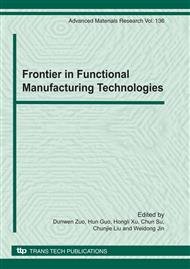p.140
p.144
p.148
p.153
p.158
p.162
p.167
p.172
p.176
The Variable Non-Linear Flow Channel Method and Device
Abstract:
In order to overcome shortcomings of traditional hydraulic control valve, the variable non-linear flow channel method and device is proposed, which can make magneto-rheological fluid channel in the magnetic gap space variable non-linear. In the magnetic gap space setting separated magnetic pressure tablets make magneto-rheological fluid non-line fluid along the separated magnetic pressure tablets, so the magneto-rheological fluid channel length is lengthen and it can increase the utilization of a limited magnetic line. Under the condition of magnetic gap size fixedness, improving pressure difference size of controllable fluid of magnetic fluids can achieve goals of energy conservation and reducing the size of magneto-rheological valves.
Info:
Periodical:
Pages:
158-161
Citation:
Online since:
October 2010
Authors:
Price:
Сopyright:
© 2010 Trans Tech Publications Ltd. All Rights Reserved
Share:
Citation:


